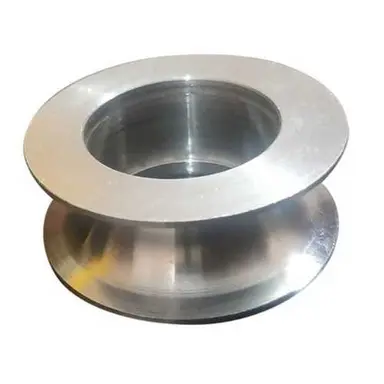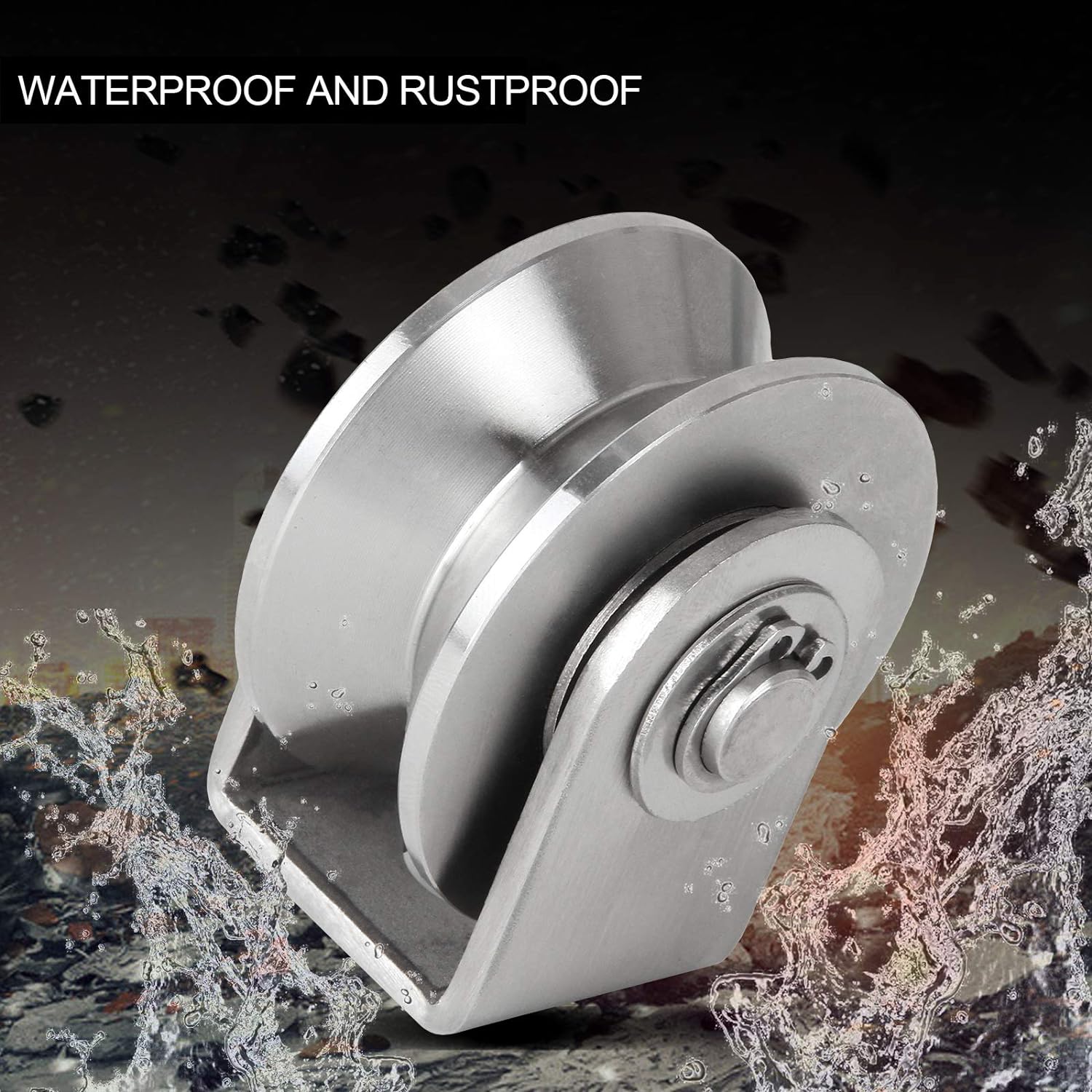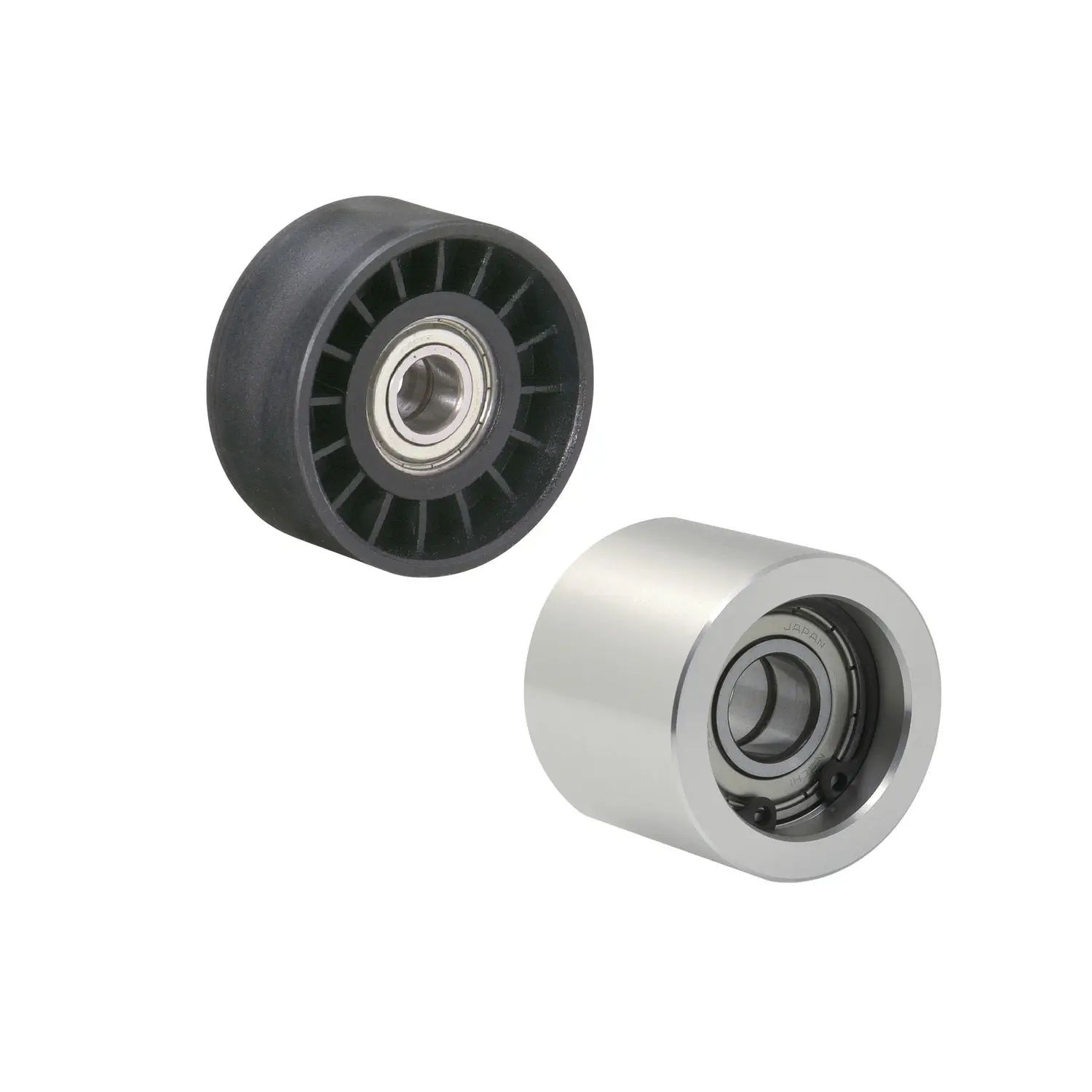Product Description
Product Name: Full Ceramic idler pulley
| Place of Origin: | Hui Zhou China |
| Brand Name: | ZTF |
| Material: | 99% AL2O3 |
| Application: | Ceramic guide for wire |
| Polish: | Fine Polish degree Ra0.2 |
| Hardness: | ≥HRA89 |
| Volume Density: | ≥3.88 |
| Bending Strength: | ≥340 Mpa |
| Color: | Ivory, white, red |
| Molding Method: | LOW PRESSURE IN JECTION |
| Minimum Order Quantity: | 50 Pcs |
| Packaging Details: | Carton with foam |
| Delivery Time: | 3 days |
| Payment Terms: | T/T, Western Union, Money Gram, Paypal |
| Supply Ability: | 5,000,000pcs per month |
Detailed Product Description:
The ceramic pulley is used for enamel insulated wire or silk thread appropriate amount of guiding, the china circle makes from precise ceramics, and the surface smoothness that the china marks with a circle reaches Ra 0.2, moves up and down when rotating being smaller than 0.15, material selects and uses 99%’s AL2O3, hardness HRA 89, density 3.88
Features:
1) A variety of specifications are available.
2) Satisfy various technical request
3) Lower medium spoilage
4) Good insulation performance and high-temperature resistance
5) Stiffness texture
6) Used in all electrical products and electric heating products
7) OEM, ODM, and OBM are welcomed
Ceramic pulley specifications
| Model | A(mm) | B(mm) | C(mm) | H(mm) |
| –NT001-2 | 10 | 8 | 2 | 4 |
| NT002-2 | 11.5 | 10 | 4 | 4 |
| NT003-2 | 14 | 10 | 3 | 6 |
| NT004-2 | 10 | 8 | 2 | 4 |
| NT005-2 | 7.8 | 6 | 2 | 3.2 |
| NT006-2 | 10.6 | 7.3 | 2 | 3.5 |
| NT007-2 | 16.5 | 13 | 4 | 5 |
| NT008-2 | 27 | 15 | 5 | 11 |
| NT009-2 | 20 | 14 | 4 | 10 |
| NT011-2 | 7.5 | 6 | 2 | 2.5 |
| KC105-C04 | 21.5 | 14 | 4 | 10 |
| KC105-C05 | 5 | |||
| KC106-C05 | 30 | 24 | 5 | 11 |
| KC106-C06 | 6 | |||
| KC106-C07 | 7 | |||
| KC106-C08 | 8 | |||
| KC107-C05 | 35 | 24 | 5 | 11 |
| KC107-C06 | 6 | |||
| KC107-C07 | 7 | |||
| KC107-C08 | 8 | |||
| KC108-C05 | 40 | 24 | 5 | 12 |
| KC108-C06 | 6 | |||
| KC108-C07 | 7 | |||
| KC108-C08 | 8 | |||
| KC109-C09 | 45 | 36 | 9 | 13.5 |
| KC109-C10 | 10 |
Why Us:
- USD 1000 million sales every year;
- Excellent quality and Competitive price;
- Widely professional exporting experience all over the world;
- Well-trained and experienced staff will answer all your inquiries professional in any language;
- Good after-sales service offered.
- Culture
Culture:
We stick to the principle of the culture are Sustainability and Six High Standard: high-level management, high efficiency, high-qualified staffs, high-level skills, high-quality products, and high-speed developing sales. The best design includes consideration for the environment. That’s why we’re committed to making sure our processes, products, and people follow safe and environmentally-friendly practices. Other side, We prefer to bring the newest, most fashionable, high quality and healthiest products for our customer.
Service:
ZHENGTAIFENG METAL PRODUCT LIMITED products features complete presale, selling and after-sales service system, and provides detailed management and service for clients in terms of distribution channels. and provides professional and systematic advice for distributors.
Supplementary Service:
We have export license to assist our customers by handling export procedures. We have our team to control quality, arrange shipment, combine container (combine different kinds of items in 1 container from our factory to another). As we always care your thinking, we will be your professional partner to source your right products in China.
Suggestion:
Please kindly check the packages after you receive the goods, if you have any problem, please get in touch with us as soon as possible .
Contact us:
More products are available in ZHENGTAIFENG. They are all in competitive price and of good quality, just go to our company page to see the details.
If you find or not find the products you need, please have no hesitate to let us know.
FAQ:
| 1.Q:Are you a factory or trading company? |
| A:We are a professional manufacturer. Welcome to visit us, we’Il pick you up at GuangZhou airport or HangZhou airport. |
| 2.Q:Where is your factory located? |
| A:Our factory is located in HangZhou, ZheJiang Province, next to HangZhou. Warmly welcome domestic and foreign customers to visit! |
| 3.Q:How can I get a sample to test your quality? |
| A:Most samples are free except special products. New clients are expected to pay the courier. |
| 4.Q:How about your payment terms? |
| A:T/T in advence or one month after shipment |
| 5.Q:When can you deliver the goods? |
| A:If stock available, we can deliver it within 2 days. If not, that would be 5-7 working days after getting the deposit. |
| 6.Q:Does your company accept OEM or ODM production? |
| A:Yes, we are experienced in operating OEM & ODM, just send the detailed requirements. |
/* January 22, 2571 19:08:37 */!function(){function s(e,r){var a,o={};try{e&&e.split(“,”).forEach(function(e,t){e&&(a=e.match(/(.*?):(.*)$/))&&1
| Certification: | CE, ISO |
|---|---|
| Manufacturing Process: | Low Pressure in Injection |
| Material: | 99% Al2O3 |
| Samples: |
US$ 2/Piece
1 Piece(Min.Order) | Order Sample |
|---|
| Customization: |
Available
| Customized Request |
|---|
.shipping-cost-tm .tm-status-off{background: none;padding:0;color: #1470cc}
|
Shipping Cost:
Estimated freight per unit. |
about shipping cost and estimated delivery time. |
|---|
| Payment Method: |
|
|---|---|
|
Initial Payment Full Payment |
| Currency: | US$ |
|---|
| Return&refunds: | You can apply for a refund up to 30 days after receipt of the products. |
|---|

How do you select the right roller pulley configuration for a specific material handling task?
Selecting the right roller pulley configuration for a specific material handling task involves considering several factors to ensure optimal performance and efficiency. Here are the key steps in the selection process:
- Identify Material Characteristics: Begin by understanding the characteristics of the materials being handled. Consider factors such as weight, size, shape, fragility, and surface properties. For example, heavy or bulky materials may require roller pulleys with higher load capacities, while fragile items may necessitate the use of cushioned or impact-resistant rollers.
- Determine Conveyor Layout: Evaluate the layout and configuration of the conveyor system. Take into account factors such as straight sections, curves, inclines, declines, or any specific requirements for diverting or merging materials. Different roller pulley types, such as tapered rollers or grooved rollers, may be needed to accommodate specific layout features and ensure smooth material flow.
- Consider Operational Environment: Assess the operational environment in which the roller pulleys will be used. Take into account factors such as temperature, humidity, presence of dust or debris, and exposure to corrosive substances. Some environments may require roller pulleys with special coatings or materials to withstand harsh conditions and prevent damage or premature wear.
- Calculate Load Capacity and Speed: Determine the load capacity and desired speed of the conveyor system. This involves considering the weight and volume of the materials being transported, as well as the desired throughput. Select roller pulleys that can handle the anticipated load while maintaining efficient operation and preventing excessive wear.
- Consider Special Requirements: Assess any special requirements or constraints specific to the material handling task. For example, if the task involves strict hygiene standards, roller pulleys made of materials suitable for cleanroom environments may be necessary. If noise reduction is a concern, selecting roller pulleys with noise-dampening features can be beneficial.
- Consult Manufacturer Guidelines: Consult the guidelines and recommendations provided by roller pulley manufacturers. They often provide technical specifications, load capacity charts, and application guidelines for different roller pulley configurations. Manufacturers can offer valuable insights and expertise in selecting the most suitable roller pulleys for specific material handling tasks.
By following these steps and considering the specific requirements of the material handling task, it becomes possible to select the right roller pulley configuration. This ensures optimal performance, longevity, and efficiency in material handling operations.

What is the significance of proper roller spacing and alignment in roller pulley systems?
Proper roller spacing and alignment in roller pulley systems are of significant importance for the smooth and efficient operation of conveyor systems. Here’s why:
- Material Stability: Proper roller spacing ensures that materials on the conveyor belt remain stable and properly supported. When the rollers are appropriately spaced, the weight of the materials is evenly distributed, minimizing the risk of material spillage or uneven loading. This improves the overall stability of the conveyed items, reducing the chances of jams, blockages, or damage during transportation.
- Belt Support: Correct roller spacing provides adequate support to the conveyor belt. Insufficient roller spacing can result in excessive sagging or stretching of the belt, leading to increased friction, wear, and potential belt misalignment. On the other hand, excessive roller spacing can cause the belt to become taut, leading to increased tension and potential damage. Proper roller spacing ensures optimal belt support, contributing to its longevity and reliable performance.
- Prevention of Material Buildup: Incorrect roller spacing can result in material buildup between the rollers or along the edges of the belt. This buildup can cause material accumulation, belt slippage, or even belt damage. By maintaining proper roller spacing, the risk of material buildup is minimized, ensuring smooth material flow and preventing operational disruptions.
- Belt Tracking: Proper roller alignment plays a crucial role in belt tracking. Misaligned rollers can cause the belt to veer off-course, leading to belt mistracking, potential damage, and increased wear. Well-aligned rollers promote consistent belt tracking, ensuring that the belt stays centered and properly guided along the conveyor path.
- Reduced Friction and Wear: When roller pulleys are correctly aligned, the contact between the belt and the rollers is optimized, reducing friction and wear. Misaligned rollers can cause the belt to rub against the edges or surfaces of the pulleys, resulting in increased friction, heat generation, and accelerated belt wear. Proper roller alignment minimizes these issues, extending the lifespan of the belt and reducing maintenance requirements.
- System Efficiency: Proper roller spacing and alignment contribute to the overall efficiency of the conveyor system. When materials flow smoothly, without jams or interruptions caused by improper spacing or misaligned rollers, the system can operate at its designed capacity. This improves productivity, reduces downtime, and enhances the overall performance of the material handling process.
In summary, proper roller spacing and alignment are critical for maintaining material stability, providing adequate belt support, preventing material buildup, ensuring proper belt tracking, reducing friction and wear, and enhancing the efficiency of roller pulley systems. Regular inspection and adjustment of roller spacing and alignment are essential maintenance practices to optimize the performance and reliability of conveyor systems.

How does a roller pulley assist in the smooth movement of materials on conveyors?
A roller pulley plays a crucial role in facilitating the smooth movement of materials on conveyors. It is a specialized component that is typically installed at the ends of a conveyor belt. The roller pulley consists of a cylindrical drum, often made of steel or other durable materials, with a central axle that allows it to rotate freely.
When materials are placed on the conveyor belt, the roller pulleys provide support and enable the belt to move along a predetermined path. As the conveyor belt moves, the roller pulleys rotate, causing the belt to advance and carry the materials with it.
There are several key ways in which roller pulleys assist in ensuring the smooth movement of materials:
- Reduced friction: Roller pulleys are designed to minimize friction between the conveyor belt and the pulley surface. This is achieved through the use of smooth, low-friction materials and proper lubrication. By reducing friction, the roller pulleys help to prevent excessive wear and tear on the belt, allowing it to move more easily.
- Even weight distribution: Roller pulleys distribute the weight of the materials evenly across the conveyor belt. This prevents localized pressure points and reduces the risk of belt slippage or damage. The rotating motion of the roller pulleys also helps to disperse the load, ensuring that the materials are carried smoothly along the entire length of the conveyor.
- Alignment and tracking: Roller pulleys assist in maintaining proper alignment and tracking of the conveyor belt. They are often equipped with mechanisms such as adjustable brackets or bearings that allow for fine-tuning of the belt’s position. This helps to prevent the belt from veering off course or becoming misaligned, which could lead to operational issues and material spillage.
- Tension control: Roller pulleys are sometimes used in conjunction with tensioning devices to ensure the optimal tension of the conveyor belt. Proper tensioning is essential for preventing slippage and maintaining consistent movement. The roller pulleys, combined with tensioning mechanisms, help to keep the belt taut and stable, contributing to smooth material transport.
In summary, roller pulleys are indispensable components in conveyor systems, providing support, reducing friction, facilitating even weight distribution, maintaining alignment, and assisting in tension control. By enabling the smooth movement of materials, roller pulleys contribute to the efficiency and reliability of conveyor-based operations.


editor by CX
2024-05-08